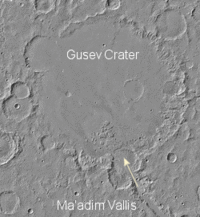Difference between revisions of "Gusev Crater"
(correct link) |
|||
| Line 3: | Line 3: | ||
==An ancient lake?== | ==An ancient lake?== | ||
The crater exhibits evidence that it once contained substantial quantities of liquid [[water]]. A channel enters the south of the crater. Known as [[Ma'adim Vallis]], this was almost certainly a means for which the crater was supplied with water. On January 9th, 2004, the [[Spirit]] rover landed in the crater and began to analyse the surrounding rock. Expecting to find overwhelming evidence of an ancient lake, mission scientists were disappointed to find very little indication of water. | The crater exhibits evidence that it once contained substantial quantities of liquid [[water]]. A channel enters the south of the crater. Known as [[Ma'adim Vallis]], this was almost certainly a means for which the crater was supplied with water. On January 9th, 2004, the [[Spirit]] rover landed in the crater and began to analyse the surrounding rock. Expecting to find overwhelming evidence of an ancient lake, mission scientists were disappointed to find very little indication of water. | ||
| + | |||
| + | [[Image:GusevCrater.gif|thumb|200px|right|image of the Gusev Crater]] | ||
Although this was unexpected, during the trip to the [[Columbia Hills]], Spirit eventually found evidence that the area had once held a quantity of saltwater.<ref>[http://en.wikipedia.org/wiki/Gusev_Crater Gusev Crater on Wikipedia]</ref><ref>[http://marsrovers.nasa.gov/newsroom/pressreleases/20070521a.html NASA press release, May 21, 2007. Evidence for water in Gusev Crater]</ref> | Although this was unexpected, during the trip to the [[Columbia Hills]], Spirit eventually found evidence that the area had once held a quantity of saltwater.<ref>[http://en.wikipedia.org/wiki/Gusev_Crater Gusev Crater on Wikipedia]</ref><ref>[http://marsrovers.nasa.gov/newsroom/pressreleases/20070521a.html NASA press release, May 21, 2007. Evidence for water in Gusev Crater]</ref> | ||
Revision as of 11:56, 29 November 2008
The Gusev Crater was named in 1876 after Russian astronomer Matvei Gusev (1826–1866).[1] The crater (created by a large meteorite impact approximately 3.9 billion years ago during the Late Heavy Bombardment) is located 175.4°E 14.6°S, just south of the equator. It is 144 km (90 mi) in diameter and provided an ideal landing zone for one of the MER rovers, Spirit.
An ancient lake?
The crater exhibits evidence that it once contained substantial quantities of liquid water. A channel enters the south of the crater. Known as Ma'adim Vallis, this was almost certainly a means for which the crater was supplied with water. On January 9th, 2004, the Spirit rover landed in the crater and began to analyse the surrounding rock. Expecting to find overwhelming evidence of an ancient lake, mission scientists were disappointed to find very little indication of water.
Although this was unexpected, during the trip to the Columbia Hills, Spirit eventually found evidence that the area had once held a quantity of saltwater.[2][3]







